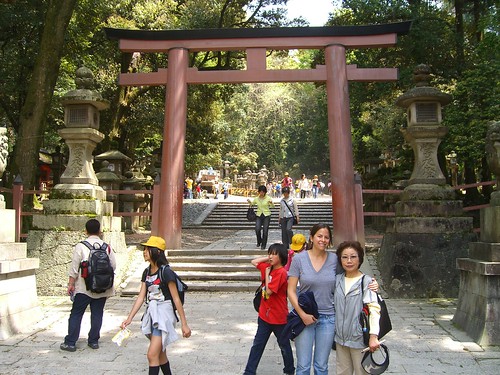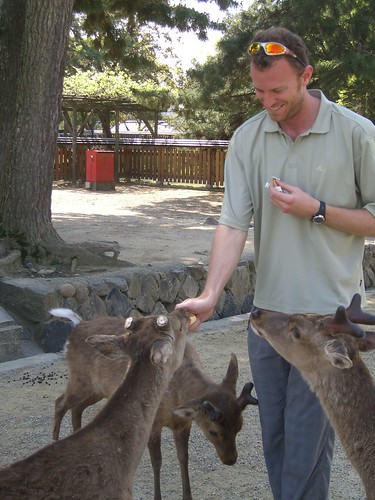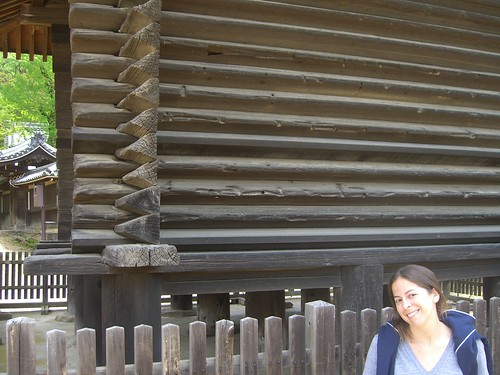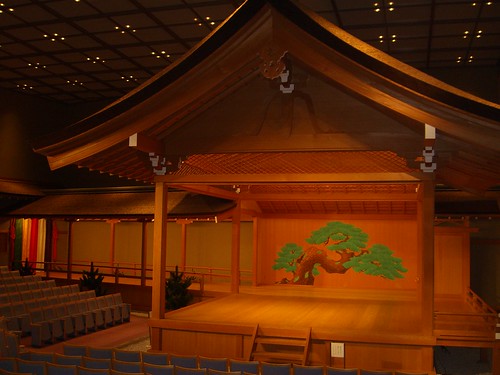

After such an early start for the
Buddhist ceremony, and walking around Koya-san, and then the trip to
Nara, we were dead on our feet when we got there. The tourist
information desk booked us into a nearby hotel. After about
two-weeks in Japanese style rooms we both wanted real beds. The
futons-on-Tatami mats are fairly comfortable, but a little firmer
than we're used to, and we got to the point of longing for a deep
soft mattress. We checked into a perfectly fine “business hotel”.
Real beds, private loo & shower/bath, and internet in the room.
Also, (sound of trumpets here), coin-op laundry. We had an exquisite
night of doing nothing.
We did, however, go out for some food.
Just around the corner from our hotel was a little sushi shop where
the plastic food in the window looked particularly appealing. These
display cases are everywhere here, but I gotta say that sometimes the
presentation has the opposite effect than the proprietor intended.
This time, however, I am happy to report that Susan's sushi-radar
continued to serve well, and we had a fantastic meal that would have
easily been four times the price in California. Sushi is really the
only thing here that is cheaper than at home, something we have been
taking aggressive advantage of.

The next morning we got a reasonably
early start. The YMCA in Nara arranges free, English language tours,
and we had arranged to meet our “goodwill guide” at 9am. The
tour was fantastic, just the cure for the temple-fatigue that was
starting to set in. Our tourguide was a very nice lady with good
English and an encyclopedic knowledge. In four hours we learned more
about Japan than we had gathered thus far in two weeks.


By legend, deer are sacred in Nara,
having been the harbinger of an important Shinto Diety moving to the
city. There are over one-and-a-half thousand deer in and around the
central park of Nara, which is big, but still very full of deer. The
deer feed primarily on these little rice cakes that are baked
especially so tourists can buy them to feed the deer. It's actually
forbidden to bring them cabbage or what not from home, as this trains
the deer to pillage the gardens and fields nearby. Also, according
to tradition, the deer are very polite, and will bow to you if you
bow to them. I'm happy to report that they do indeed bow, and then
head butt you in the leg until it is clear all of your rice cakes
have been eaten.

Nara also houses the largest Bronze
statue in the world. It is a big Buddha cast in the 8th
century. It's a little over 30 meters tall, which puts each of its
ears taller than I stand, and each curl of hair bigger than a human
head. A child could fit in each nostril. Being an engineer, I was
tremendously interested in how they cast such a huge thing in an era
when everything was human powered. Well, it was done in stages, and
cast by building a mold around the clay positive (which was then
chipped away). A large hill was built around the site in order to
reach the desired height. After the statue was complete, and the
hill removed, the great pagoda was built around the statue. Sadly,
the pagoda was not to last, and after about 2 centuries the Buddha
was out in the cold, where he would sit for more than 500 years.
Eventually a new pagoda was built, at 2/3 the size of the original.
By this time the massive cedar trees that were used as pillars were
no longer to be found in Japan. The spread of Buddhism apparently
not accompanied by a spread of sustainable forestry practices. It
would take about 800 years to grow a tree of the proper size, so the
pagoda today is held up by pillars made by bolting together smaller
pieces of wood.


Buddha and his two attendant
Bhoddisatvas sit on giant bronze lotus flowers. The lotus flower is
a sacred symbol in Buddhism is because it grows up out of the mud,
yet blossoms with a pure and beautiful flower. A Boddisatva is a
human, destined to be a future Buddha. We also got a nifty little
chart of Buddist deities that instantly clarified two weeks of
aquired questions in Japanese mythology. There are these cool
“guardians” adapted from Hindu that sit the entry to all of the
Bhuddist temples in Japan. Rather than lotus flowers, they are
perched atop demons which they are crushing beneath their feet.

We also visited a Shinto shrine, where
Susan tempted fate and got a fortune. Fortunately, she is destined
for “Great Good Fortune” and everything is honky-dory. Had it
not been so, all is not lost. Those who receive fortunes they don't
like tie them knots around trees or strings throughout the temple,
hopeful the gods will see this and grant a new fate. These are
everywhere, and from a distance can give the impression of blossoms.
At the Shinto shrine there is an old
treasury, mainly used for storing the artifacts. These are
constructed in a unique way. The basic assembly is sort of like a
log cabin, but each log has been hewn such that it has a triangular,
not circular, profile. With no bark the logs then take on moisture
during the wet season, swelling to make the walls water tight. In
the dry they shrink, and allow air to pass through the treasury,
preventing dank.

We also saw a Noh theater. Less famous
in the west than Kabuki, Noh actors wear masks and as I understand
it, present less ritualized performances.

After walking back to the station we
bid our tourguide a fond farewell, and nearly collapsed into the
chairs at the sushi restaurant. This was the same place that we had
dinner the night before. Today we sat at the sushi bar, the place
was empty but for a sake-bottle fiend and us. Rather than point to
the pictures on the english-language menu, I picked up the specials
(all in Kanji) and gestured to the chef. Between his english and my
gesticulations we got the point across and he decided for us. The
first course? A fish right out of the tank behind him. We were too
slow to get a photo of him catching our lunch, but I am happy to
report that the head would occasionally twitch as we were eating. I
kept saying “did you see it move” but I think Susan thought I was
kidding until she noticed one nice big twich and just about jumped
out of her skin. We all got a big laugh out of this (the chefs most
of all) and everything after that was even better – a reward it
would seem for being good sports (or just entertaining on a slow
afternoon).

Next stop is Nikko, north of Tokyo.
We'll spend 3 nights, which is a lot for this small town, but one of
the days is my 30th birthday and Susan doesn't want us to
have to deal with trains etc. It's a pretty decent hike, four
trains, but only about 6 hours. When we were getting instructions at
the station the tourist advisor had very wide eyes. This is roughly
equivalent to walking up to someone in Grand Central station in NYC
and asking how to get to Lake Woebegone Michigan... tonight. We have
a Japan Rail pass, so this is free for us, but we estimated that
otherwise we would have shelled out over US$350 for this little
jaunt. Gotta love the JR pass.
Once again we proved that happiness on
the road is a full belly. And warm with the hospitality of our
various hosts in Nara, we were off to the train station to get to
Nikko.
